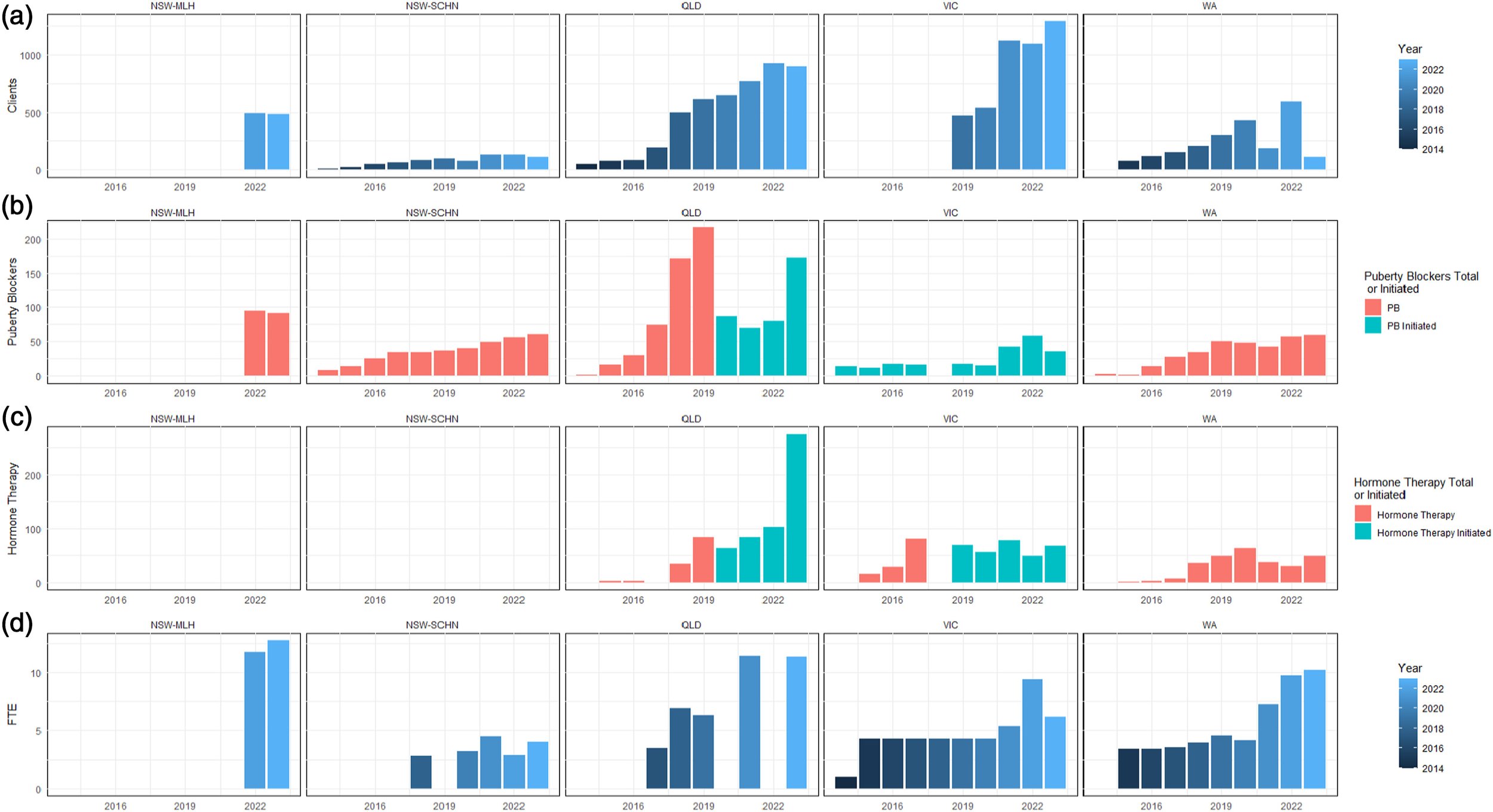What Does The Data Tell Us About Gender Affirming Care?
In line with international trends, Australian gender clinics have experienced an unexplained explosion in the number of patient referrals over the past decade.
During that time, requests for data on patient numbers, their treatments, and rates of regret or detransition have uncovered systemic deficiencies in record keeping - an anomaly in modern medical practice.
Some international gender clinics have also experienced issues with record-keeping or reluctance to disclose.
Without rigorous, long-term data, it’s impossible to properly assess the real risks and benefits of gender affirming care.
How Many patients are there? A timeline
Information on the number of referrals and patients seen by public Australian gender clinics is incomplete. Most of the available data, below, has had to be obtained via Freedom of Information requests.
It is also unlikely to be the full picture — the number of clients seen in private clinics is still unknown because gender-affirming treatments often lack separate Medicare item numbers.
APRIL 2024
A summary of data compiled from Freedom of Information requests sent to gender services operating in Australian public hospitals and health services found:
Clients of gender services have increased rapidly in Queensland (2017:190 – 2022:922) and in Victoria (2019:472 – 2023:1290).
There is no routine or public information about the nature of treatment, number of patients, or outcomes of treatments provided by public services offering gender-affirming care to minors.
Not all public gender services provided information on the number of clients seen, their treatments, or their sex
NSW's busiest gender clinic, Maple Leaf House, was unable to provide any data at all on the number of adolescents treated with hormone therapy, or their sexes at birth. Maple Leaf House reported that their database ‘does not hold the information in the format requested’.
The author of the summary, Andrew Amos wrote:
"…even with the aid of FOI requests, it is impossible to draw any strong conclusions about the nature, quality, or outcomes of the GAMOC in Australia."
MARCH 2024
The publication AusDoc sought information on patient outcomes, regret rates, and ongoing research from Australian publicly funded gender clinics. Overall, most clinics were reluctant to provide comprehensive information, with some declining to engage entirely.
NOVEMBER 2023
The Age reported that a request to the Victorian government for more detailed data on gender clinics had been declined:
“Two months after The Age was promised a number of other key statistics, including how many referrals to the gender clinics proceeded to medical treatment, how many young people were put on puberty-delaying drugs called “puberty blockers”, and how many then proceeded to hormone therapy, the government refused to answer, citing privacy considerations.“No figures are available for how many people are being treated in doctors’ clinics because no separate Medicare number exists for cross-gender treatment."
The report also noted:
“Nationally, figures for hospital-based gender clinics are more mixed, with referrals to Western Australia’s clinic declining since a peak in 2021, while South Australia’s referrals have continued increasing. The gender clinics in NSW and Queensland did not supply sufficient data to make comparisons.” - Reported by Michael Bachelard for The Age
JULY 2023
The ABC reported:
“In December last year, Westmead had just 145 patients on its books, compared with 1,095 patients at Melbourne's gender clinic and 922 patients at Queensland's gender service.” - Reported by Patricia Karvelas, Lesley Robinson and Carla Hildebrandt for The ABC
OCTOBER 2022
Partial figures obtained by Dr Dianna Kenny showed that between 2014 and 2021 the number of minors enrolled in Australia’s public gender clinics rose from 211 to 2067.
The figures don’t provide segmentation by age or sex.
SEPTEMBER 2022
The NSW Labor MLC, Greg Donnelly, who began filing Freedom Of Information Requests with public gender clinics back in 2017, told a Budget Estimates Hearing for Health:
"I actually think that what we have in plain sight is an absolutely scandalous situation that is playing out in real time. There appears to be, for some reason or another, a lack of willingness at the highest level in health in this country—at the political level and at the bureaucratic level—to confront this issue and come to terms with the significance of what's going on." - NSW Labor MLC, Greg Donnelly
2006- 2022
Melbourne’s Royal Children’s Hospital gender clinic reported that referrals dropped for the first time since 2006.
Victorian Government records show that after rising dramatically and peaking at 820 in 2021, referrals dropped to 634 in 2022.
MARCH 2021
After requesting state-level data on gender clinic patients from the Health Chiefs Executive Forum, Senator Claire Chandler was informed by the Forum that “no information about the number or nature of patients was collected. "
2003 - 2013
Reportedly, the first referrals of children for gender services were made in 2003 in Melbourne and 2013 in Sydney.
How many prescriptions or surgeries are being provided?
DO WE HAVE DATA ON PRESCRIPTIONS FOR HORMONAL TREATMENTS?
The Therapeutic Goods Administration hasn’t approved hormonal treatments for use in gender care for minors, making all use ‘off-label’. Because data isn’t collected on off-label prescriptions, precise figures on are unavailable.
In August of 2024, a study revealed that a significant portion of PBS-subsidized testosterone is being used by natal women for gender affirmation.
The study, published in the Medical Journal of Australia, found that from July 2021 to June 2022, 59% of people aged 40 or younger receiving subsidised testosterone had current or past female gender markers.
The study explains:
"As the PBS does not list gender affirmation as an indication for prescribing testosterone, clinicians use the authority indication “androgen deficiency due to an established pituitary or testicular disorder”, regardless of gender identity markers, in accordance with national guidelines."Those guidelines are the Position statement on the hormonal management of adult transgender and gender diverse individuals.
Data showing a significant increase in testosterone prescriptions for women in this context was published in Gender Clinic News in 2023.
DO WE KNOW THE NUMBER OF AFFIRMING OR REVERSAL SURGERIES BEING PERFORMED?
Figures on gender affirming surgeries aren’t recorded because the procedures currently lack unique Medicare item numbers.
However, plastic surgeons told The Australian in 2023 that they were seeing the number of transition and reversal surgeries rising steadily, with mastectomy appearing to be one of the most sought-after procedures for under 18s.
What are the rates of regret, desistance or detransition?
FOR A FULL OVERVIEW SEE DETRANSITION, DESISTANCE, REGRET
Studies make wildly different estimates about the prevalence of detransition, desitance or regret, but there are no high-quality studies providing evidence for claims that the rate is as low as 1%.
Because of the low-quality of research in this area, and because gender affirming providers don’t have formal reporting obligations, the true rates of detransition or regret are unknown, but likely to be underestimated.
-
Amos AJ. Rapidly expanding gender-affirming care based on consensus instead of evidence justifies rigorous governance and transparency. Australasian Psychiatry. 2024;32(4):346-353. doi:10.1177/10398562241249579
NSW health minister declines to intervene to force gender data fix at Maple Leaf House. https://archive.md/VyW3L
GPs trained to prescribe hormones to trans teens thanks to government funding. https://archive.md/uRAOf
ABC News. Controversial research pulls Westmead children's hospital into centre of fight over gender care. Published July 10, 2023. Accessed November 20, 2024. https://www.abc.net.au/news/2023-07-10/transgender-children-westmead-hospital-research-four-corners/102568570
Kenny D. Number of children enrolled receiving puberty blockade and cross-sex hormones in five gender clinics in Australia 2014-2021. https://diannakenny.com.au/number-of-children-enrolled-receiving-puberty-blockade-and-cross-sex-hormones-in-five-gender-clinics-in-australia-2014-2021/
Parliament of New South Wales. Portfolio Committee No. 2 - Health - 7 September 2022 - CORRECTED. https://www.parliament.nsw.gov.au/lcdocs/transcripts/3037/Transcript%20-%20PC%202%20-%20Health%20-%207%20September%202022%20-%20CORRECTED.pdf
Chandler C. Liberal Senator for Tasmania discusses the lack of transparency and data availability from gender clinics [video]. March 17, 2021. https://www.youtube.com/watch?feature=shared&v=NcInKPauiQI
AusPATH. Report on trans health care history. https://auspath.org.au/wp-content/uploads/2022/05/AusPATH-Report-on-trans-health-care-history.pdf
Health leaders reject the need for oversight of transgender medicine. https://archive.li/nfWAP
BJ, Zwickl S, Zajac JD, Cheung AS. Gender affirmation testosterone therapy, Australia, 2021-22: a review of PBS dispensing data. Med J Aust. 2024;221(9):491-492. doi:10.5694/mja2.52415 Available at: https://onlinelibrary.wiley.com/doi/10.5694/mja2.52415
Cheung AS, Wynne K, Erasmus J, et al. Position statement on the hormonal management of adult transgender and gender diverse individuals. Med J Aust 2019; 211: 127-133. https://www.mja.com.au/journal/2019/211/3/position-statement-hormonal-management-adult-transgender-and-gender-diverse
Plastic surgeons call for age limit as young teenagers line up for 'top surgery'. https://archive.md/gEiEw#selection-629.106-629.135
Cohn A. The detransition rate is unknown: a critical evaluation of the current literature on detransitioning and its implications for clinical practice. Arch Sex Behav. 2023;52(5):2115-2129. https://link.springer.com/article/10.1007/s10508-023-02623-5






